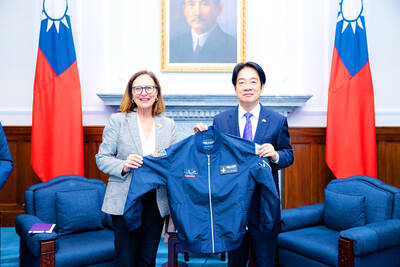A trio of oil companies led by Chevron Corp has tapped a petroleum pool deep beneath the Gulf of Mexico that could boost the US reserves by more than 50 percent. A test well indicates it could be the biggest new domestic oil discovery since Alaska's Prudhoe Bay a generation ago.
But the vast oil deposit roughly 6.4km beneath the ocean floor will not significantly reduce the country's dependence on foreign oil and it won't help lower prices at the pump anytime soon.
"It's a nice positive, but the US still has a big difference between its consumption and indigenous production," said Art Smith, chief executive of energy consultant John S. Herold. "We'll still be importing more than 50 percent of our oil needs."
Chevron on Tuesday estimated the 777km2 region where its test well sits could hold between 3 billion and 15 billion barrels of oil and natural gas liquids. The US consumes roughly 5.7 billion barrels of crude oil in a year.
It will take many years and tens of billions of dollars to bring the newly tapped oil to market, but the discovery carries particular importance for the industry at a time when Western oil and gas companies are finding fewer opportunities in politically unstable parts of the world, including the Middle East, Africa and Russia.
The proximity of the Gulf of Mexico to the world's largest oil consuming nation makes it especially attractive. And it could bring pressure on Florida and other states to relax limits they have placed on drilling in their offshore waters for environmental and tourism reasons.
The country's reserves currently are more than 29 billion barrels of oil equivalent, according to the US Energy Department. But the US imports most of its oil from abroad and its overall supply is tiny when compared with, say, Saudi Arabia, whose reserves exceed 250 billion barrels.
Chevron's well, called "Jack 2," was drilled about 8.5km below sea level.
The well was drilled in the Walker Ridge area of the Gulf, about 434.5km southwest of New Orleans and 282km off the coast of Louisiana. It followed up a discovery made by Chevron in 2004.
San Ramon, California-based Chevron said the well set a variety of records, including the deepest well successfully tested in the Gulf of Mexico. Chevron said the well was drilled more than 6,096m under the sea floor below 2,134m of water for a total depth of 8,599m.
Chevron has a 50 percent stake in the field, while partners Statoil ASA of Norway and Devon Energy Corp of Oklahoma City own 25 percent each.
During the test, the Jack 2 well sustained a flow rate of more than 6,000 barrels of oil per day, but analysts and executives believe the payoff could be much larger than that.
The successful test well does not mean a huge supply of cheap oil will hit the market anytime soon.
Oppenheimer & Co analyst Fadel Gheit estimated that the first production for the Chevron-led partnership might not come on line until after 2010, depending on how many more test wells the companies drill.
That said, many companies stand to benefit from their own projects in the so-called lower tertiary, a rock formation that is 24 million to 65 million years old.

RESPONSE: The transit sends a message that China’s alignment with other countries would not deter the West from defending freedom of navigation, an academic said Canadian frigate the Ville de Quebec and Australian guided-missile destroyer the Brisbane transited the Taiwan Strait yesterday morning, the first time the two nations have conducted a joint freedom of navigation operation. The Canadian and Australian militaries did not immediately respond to requests for comment. The Ministry of National Defense declined to confirm the passage, saying only that Taiwan’s armed forces had deployed surveillance and reconnaissance assets, along with warships and combat aircraft, to safeguard security across the Strait. The two vessels were observed transiting northward along the eastern side of the Taiwan Strait’s median line, with Japan being their most likely destination,

‘NOT ALONE’: A Taiwan Strait war would disrupt global trade routes, and could spark a worldwide crisis, so a powerful US presence is needed as a deterrence, a US senator said US Senator Deb Fischer on Thursday urged her colleagues in the US Congress to deepen Washington’s cooperation with Taiwan and other Indo-Pacific partners to contain the global security threat from China. Fischer and other lawmakers recently returned from an official trip to the Indo-Pacific region, where they toured US military bases in Hawaii and Guam, and visited leaders, including President William Lai (賴清德). The trip underscored the reality that the world is undergoing turmoil, and maintaining a free and open Indo-Pacific region is crucial to the security interests of the US and its partners, she said. Her visit to Taiwan demonstrated ways the

GLOBAL ISSUE: If China annexes Taiwan, ‘it will not stop its expansion there, as it only becomes stronger and has more force to expand further,’ the president said China’s military and diplomatic expansion is not a sole issue for Taiwan, but one that risks world peace, President William Lai (賴清德) said yesterday, adding that Taiwan would stand with the alliance of democratic countries to preserve peace through deterrence. Lai made the remark in an exclusive interview with the Chinese-language Liberty Times (sister paper of the Taipei Times). “China is strategically pushing forward to change the international order,” Lai said, adding that China established the Asia Infrastructure Investment Bank, launched the Belt and Road Initiative, and pushed for yuan internationalization, because it wants to replace the democratic rules-based international

RELEASED: Ko emerged from a courthouse before about 700 supporters, describing his year in custody as a period of ‘suffering’ and vowed to ‘not surrender’ Former Taiwan People’s Party (TPP) chairman Ko Wen-je (柯文哲) was released on NT$70 million (US$2.29 million) bail yesterday, bringing an end to his year-long incommunicado detention as he awaits trial on corruption charges. Under the conditions set by the Taipei District Court on Friday, Ko must remain at a registered address, wear a GPS-enabled ankle monitor and is prohibited from leaving the country. He is also barred from contacting codefendants or witnesses. After Ko’s wife, Peggy Chen (陳佩琪), posted bail, Ko was transported from the Taipei Detention Center to the Taipei District Court at 12:20pm, where he was fitted with the tracking